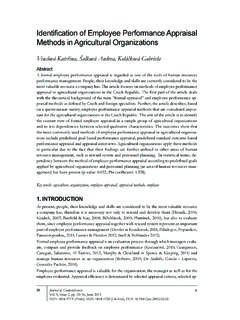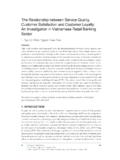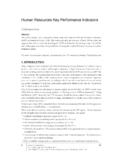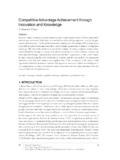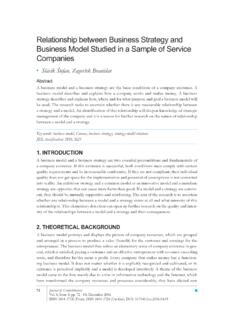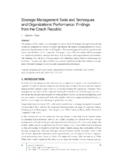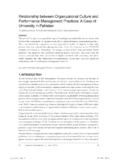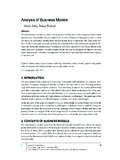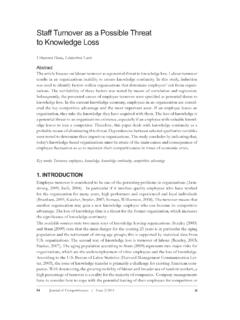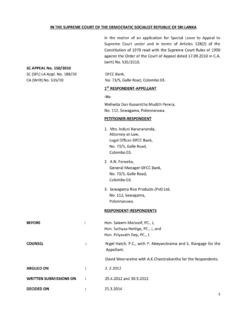Transcription of The Nursing Shortage Impact on Job Outcome …
1 The Nursing Shortage Impact on Job Outcome (The Case in Sri Lanka)Kumari Shammika Senani Mudihanselage Hellerawa, De Alwis Chamaru AdambarageAbstract The Nursing Shortage is a common problem throughout the world. Nurses form the largest proportion of the healthcare system and play a significant role in providing direct patient care. Considering the importance of the role of nurses in the healthcare system, it is important to investigate how Nursing Shortage effects the quality of patient care, nurses job satisfaction and their work stress. A study was conducted to investigate the correlation between these at the Polonnaruwa District General Hospital in Sri Lanka with a random sample of nurses) working in the hospital and using a self-administered questionnaire.
2 This study uses an explanatory re-search design. The statistical analysis confirmed a positive relationship between nurse Shortage and workload. It also shows a significant positive relationship between workload and the quality of patient care. Furthermore, a negative relationship was observed between workload and the quality of patient care. In addition, this study calculates the mean effect of emotional intelli-gence of these factors, and a significant correlation is found between emotional intelligence and workload as well as work stress. There is a firm evidence that in Sri Lanka, Nursing Shortage influences the workload of the employee, finally affecting the quality of patient care.
3 In addition, the study recognized the capability of nurses to manage their emotions as well as emotions of others, which has increased their tolerance to control psychological stress in performing their duty. This study confirms that nurse s emotional intelligence act as a partial moderating variable for job outcomes of : Patient care, Job satisfaction, Work Stress, Emotional Intelligence, Workload and Shortage of Nurses JEL Classification: O151. INTRODUCTIONN urses are the backbone of any healthcare system and their workload is multifaceted and very complex. However, there is a Nursing Shortage as can be seen all over the world (IOM, 2011, The Global Shortage of Registered Nurses , 2013, Nursing Shortage , 2014).
4 It is having an adverse Impact on health systems around the world (Oulton, 2006). The Nursing Shortage can be defined as an overarching imbalance of supplying and demand attributed to demographics, qualifications, availability and willingness to do the work (Kimball & O Nell, 2002). However, generally, when the number of nurses is not enough to provide high quality of care, it can be de-fined as a Shortage of Nurses (SN) (Toh et al., 2012). However, as per Birch et al. (2003) admin-istrators fail to determine the quantity of nurses needed to provide high quality of care. Further, in economic terms, SN emerges when there are an insufficient number of nurses to provide the best quality standards and no funds to facilitate additional positions.
5 Thus, defining SN is dif- Journal of Competitiveness Vol. 7, Issue 3, pp. 75-94, September 2015 ISSN 1804-171X (Print), ISSN 1804-1728 (On-line), DOI: 14:27:52 Journal of Competitiveness ficult and complex. Nurses in countries with distinctly different healthcare systems report simi-lar shortcomings in their work environments and the quality of hospital care. The widespread Nursing Shortage and nurses high turnover have become a global issue ( The Global Shortage of Registered Nurses , 2013). The SN in hospitals and their consequences, particularly uneven quality of care, have become commonplace. Douglas (2010) suggests that Healthcare administra-tors need to collaborate in order to develop a viable and sustainable formula for safe staffing.
6 Nursing workload measures can be categorized into four levels: (1) unit level, (2) job level, (3) patient level, and (4) situation level (Carayon & Gurses, 2005). The situation and patient-level workloads are embedded in the job-level workload, and the job-level workload is embedded in the unit-level workload. In a clinical unit, for example, numerous Nursing tasks need to be per-formed by a group of nurses during a specific shift (unit-level workload). The type and amount of workload of nurses is partly determined by the type of unit and specialty ( , intensive care unit [ICU] nurse versus general floor nurse), which is the job-level workload. When performing their job, nurses encounter various situations and patients, which are determinants of the situa-tion- and patient-level workloads (Carayon & Gurses, 2005).
7 Nursing workload is largely a function of the composite of the patients individual health status, particularly with respect to functioning status, individual need for Nursing care, and severity of symptoms (Mueller et al., 2010). According to Hurst (2002) several criteria are available to define whether the scale and composition of nurse staffing are adequate to meeting the needs of patients and staff. In general, these criteria include factors like as level of education, number of beds, Size of the word, acute versus chronic status of patients, the time required for individual Nursing interventions and bed occupancy . (Mueller et al.)
8 , 2010). Nursing workload is also influenced by the amount of time patients spend on Nursing wards, length of ward or hospital stay. Shorter length of stay compresses Nursing work (Duffield et al., 2009). However a majority of the studies on Nursing workload and patient safety used nurse-patient ratio as the measure of Nursing workload. According to research on workload in human factors engineering, it is well known that workload is a complex construct, more complex than the measure of nurse-patient ratio (Carayon & Gurses, 2005). The increased turnover of patients intensifies the Nursing work-load further (Needleman, 2011). Admission and discharge of patients means extra documenta-tion, general Nursing and organizational duties, thereby increasing Nursing workload (Weydt, 2009).
9 The movement of patients within wards is also a factor in Nursing workload, and one that is harder to quantify. Nursing workload can be further increased by nurses needing to accompany patients for investigations in other departments such as CT or MRI scans. Each new admission, transfer, or discharge, requires documentation, orientation, clinical assessment and management review, and other tasks associated with the patient will cause to increase workload. Previous research conducted in different countries provides strong evidence that high Nursing workloads at the unit level have a negative Impact on patient outcomes (Lang et al., 2004, Neill, 2011).
10 As per Buerhaus et al., (2005) more than 75% of registered nurses believe the Nursing Shortage presents a major problem for the quality of their work life, the quality of patient care, and the amount of time nurses can spend with patients. Further According to Buerhaus et al. 14:27:52 (2005) nurses see the Shortage in the future as a catalyst for increasing stress on nurses (98 %), lowering patient care quality (93 %) and causing nurses to leave the profession (93 %).When patient needs vary significantly, staffing is more difficult to predict and can result in an increased workload for nurses because staffing may fail to match patient needs.
